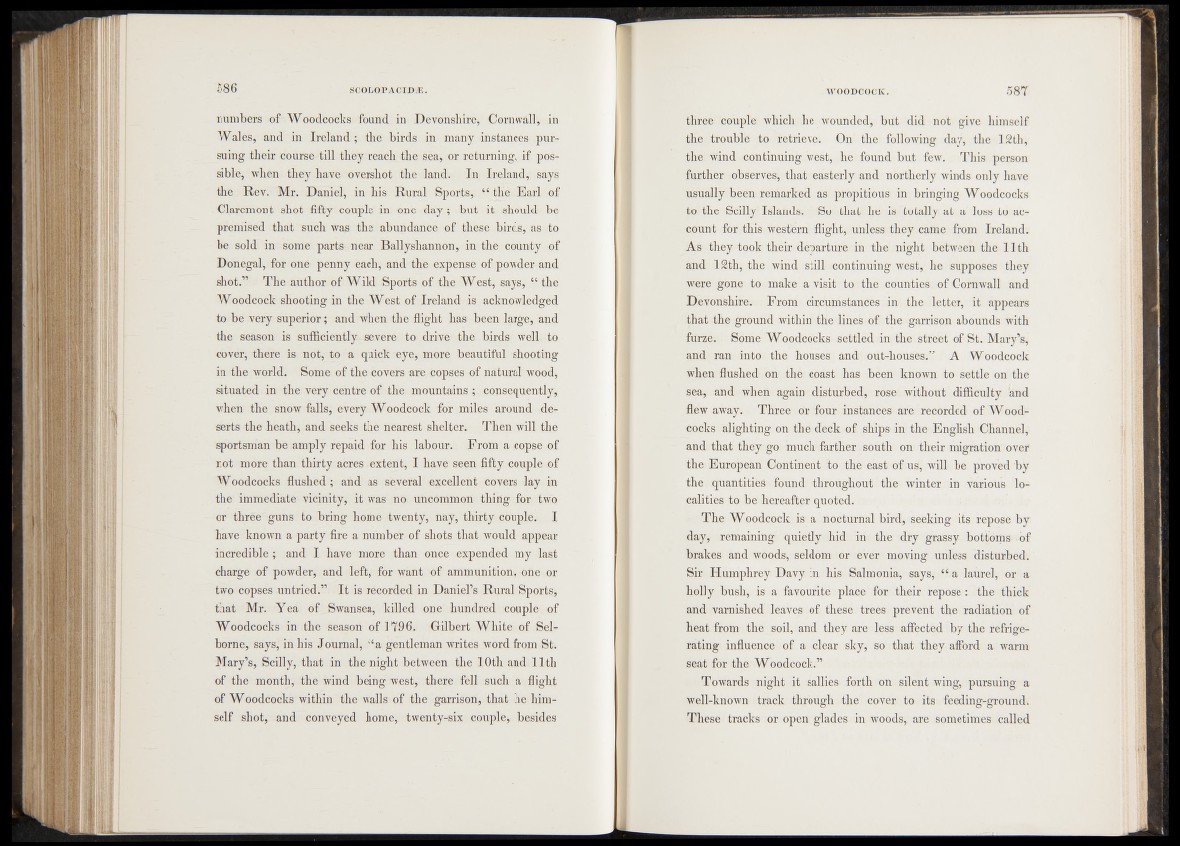
numbers of Woodcocks found in Devonshire, Cornwall, in
Wales, and in Ireland; the birds in many instances purr
suing their course -till they reach the sea, or returning, if possible,
when they have overshot the land. In Ireland, says
the Rev. 'Mr. Daniel, in his Rural Sports, “ the Earl of
. Claremont shot fifty couple in one d ay ; but it should b§
premised that "such was the abundance of these birds, as é®
be soldi inpsoniecpaajtfcmear Ballyshannon, in the county of
Donegal, for one penny each, and the expense of powder and
shot.” The author of Wild Sports of the West, says, “ the
Woodcock shooting in the West of Ireland is acknowledged
to be very superior; and when the flight has been large, and
the season is sufficiently--severe to* drive the bjrds; well to
cover, there is- not, to a quick'eye* more beautiful 'Shooting
in the world. Some of the covers are. copses of natural wood,
situated in the very centre of the mountains ; consequently,
when the snow falls, every Woodcock for.miles around deserts
the heath, and seeks the nearest shel-teT^^PjheuM will the
sportsman be amply repaid for his labour. From a copse of
not more than thirty acres^-exteht, I have seen fifty couple?of
Woodcocks flushed; and as several excellent covers lay in
the'immediate vicinity, it was no uncommon thing for two
or thrée'guns to bring home twenty, ffay, thirty couple. I
have known a party-fire a number of shots that would appear
incredible; and I have more than once expended my last
charge of powder, and left, for want of ammunition, one or
two copses untried.” . I t is recorded in Daniel’s Rural Sporty
that Mr. Yea o f. Swansea, killed one hundred couple ;©f
Woodcocks in the season of 1796. Gilbert White of Sel-
bome, says,"in his Journal, “ a gentleman writes word from St*
Mary’s, Scilly, that in the night between the 10th and 11th
of the month, the wind being west, there fell such a flight
of Woodcocks within the walls of the garrison, that he himself
shot, .and conveyed home, twenty-six couple, besides
three Icouple which he wounded, but did not give himself
the - trouble to Retrieve. On the following day, the 12th,
thei wind continuing west, .he found but few. This person
further observes, that easterly and northerly winds only have
usually been remarked as propitious in bringing Woodcocks
to the Scilly Islands. ; *So that he is, totally at a loss to.account
for this western.flight,. unless they came from Ireland.
As they took their departure in the night between the 11th
and 12th, the wind still continuing west, he supposes they
were gone to, make a visit ‘Ams the. cqurities. of Cornwall and
Devonshire. From circumstances in the letter, it appears
that the ground within fhe dines ofo the garrison abounds with
furze. Some Woodcocks settled-in the street of St. Mary’s,
and ran into the houses and out-houses.” A Woodcock
when flushed on the coast has been known to settle on the
sea, and when again disturbed, rose without difficulty and
flew away. Three or four instances are recorded of Woodcocks
alighting on the deck of ships in the English Channel,;
and that they gb muck farther. south on their migration over
the European Continent lo.rthe east of us* will be proved 'by
theV quantities found throughout the winter in various localities
to be hereafter quoted.
■ The Woodcock is a nocturnal bird, seeking its repose by
day, remaining quietly hid in the dry grassy bottoms of
brakes and woods, seldom or ever moving unless disturbed.
Sir Humphrey Davy in his Salmonia, says, “ a laurel, or a
holly bush, is a favourite place for their repose: the thick
and varnished leaves of these trees prevent the radiation of
heat from the soil, and they are less affected by the refrigerating
influence of a clear- sky* so that they afford a warm
seat for the Woodcock.”
Towards night it sallies forth on silent wing, pursuing a
well-known track through the cover to its feeding-ground.
These tracks or open, glades in woods, are sometimes called